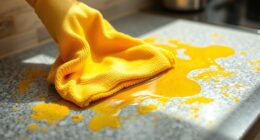To clean walls and baseboards without removing paint, use a soft microfiber cloth or sponge dampened with warm water mixed with a small amount of mild dish soap. Gently wipe from top to bottom, applying light pressure to avoid stripping the paint. Rinse the cloth frequently to remove dirt and soap residue. Dry with a clean towel to prevent streaks and water spots. For tricky spots, try adding a splash of vinegar. Keep going to discover more tips for a pristine finish.
Key Takeaways
- Dust walls and baseboards thoroughly with a dry microfiber cloth before washing to prevent scratching.
- Use a damp, well-wrung cloth with mild soap or vinegar solution, starting from the top and working downward.
- Rinse the cloth frequently in clean water to avoid spreading dirt and to minimize soap residue.
- Dry surfaces promptly with a soft towel to prevent streaks and water spots on painted areas.
- Spot clean stubborn stains gently with non-abrasive cleaners to protect paint integrity.

Keeping your walls and baseboards clean can substantially brighten a room and improve your home’s overall appearance. A tidy space feels fresh and inviting, but you might hesitate to clean your walls and baseboards out of fear of damaging the paint. Luckily, with some simple DIY cleaning tips and effective wall maintenance techniques, you can keep these surfaces spotless without risking harm to your paint job. The key is to use gentle cleaning methods and the right supplies.
Start by gathering your tools. You’ll need a soft microfiber cloth or sponge, a bucket of warm water, a mild dish soap, and possibly a spray bottle. Avoid harsh chemicals or abrasive scrubbers, as they can strip the paint or leave scratches. To begin, dust your walls and baseboards thoroughly with a dry microfiber cloth or duster to remove loose dirt and cobwebs. This step prevents dirt from smudging or scratching the surface during cleaning. For more stubborn spots, mix a small amount of mild dish soap into warm water and dampen your cloth or sponge. Wring it out well so it’s just damp, not soaked. Excess moisture is a common mistake that can lead to paint peeling or streaking.
When washing your walls, start from the top and work your way down. Use gentle, circular motions to clean the surface, paying attention to areas with visible marks or smudges. For baseboards, wipe along the length, making sure to reach into corners and crevices. If you encounter sticky spots or stubborn stains, apply a bit more pressure with a clean cloth dipped in your soapy water. For extra dirt, you can add a splash of vinegar to your cleaning solution—vinegar’s natural cleaning power helps cut through grime without damaging paint. Additionally, employing remote hackathons or virtual collaboration tools can provide tips on maintaining a clean and organized workspace, which can inspire better cleaning routines.
After washing, rinse your cloth or sponge in clean water and wipe the walls and baseboards again to remove any soap residue. This step is essential because leftover soap can leave streaks or attract more dirt. Finally, dry the surfaces with a clean, soft towel or cloth to prevent water spots and streaks. If you notice any areas where the paint appears dull or stained despite your efforts, consider spot cleaning with a gentle, non-abrasive cleaner designed specifically for painted surfaces.
Frequently Asked Questions
Can I Use a Steam Cleaner on Painted Walls and Baseboards?
You can use a steam cleaner on painted walls and baseboards, but you need to be cautious about paint safety. Verify the steam cleaner has a low or adjustable temperature setting to avoid damaging the paint. Keep the steam moving and don’t hold it in one spot for too long. This method gently cleans without harsh chemicals, but always test a small area first to prevent any potential damage.
How Often Should I Wash Walls and Baseboards?
Think of your walls and baseboards as the face of your home’s personality. You should wash them every 3 to 6 months to keep them fresh and vibrant. Establish a simple maintenance schedule that fits your lifestyle, like a gentle spring cleaning ritual. Regular cleaning prevents buildup of dirt and grime, helping your home stay inviting and beautiful. Staying consistent makes your space feel lively and cared for, year-round.
Are There Safe Cleaning Products for Delicate or Antique Paint?
When cleaning delicate or antique paint, you should use gentle cleaning products to preserve the paint. Look for mild, pH-neutral cleaners or make a simple solution with water and a few drops of dish soap. Always test a small, hidden area first. Avoid harsh chemicals or abrasive scrubbing, as these can damage the paint. Gentle cleaning helps maintain your walls’ beauty while ensuring paint preservation for years to come.
What Should I Do if Paint Starts Peeling During Cleaning?
Imagine your walls staging a dramatic peel-off, like a bad magic trick. If paint starts peeling during cleaning, stop immediately. Gently dry the area and apply a paint touch-up to seal edges. To prevent future peeling, use peeling prevention techniques—like avoiding excessive moisture and using gentle cleaning methods. This keeps your walls looking fresh and avoids the horror of ongoing paint drama. Stay proactive, and your walls will thank you.
Can I Use a Vacuum to Remove Dust Before Washing?
Yes, you can use a vacuum to remove dust before washing. Vacuum dusting is an effective dry cleaning method that quickly lifts dust, dirt, and cobwebs without disturbing paint. Just attach a soft brush or upholstery nozzle and gently go over walls and baseboards. This pre-cleaning step helps prevent smudges and streaks during washing, ensuring a cleaner, fresher look without risking paint damage.
Conclusion
By following these gentle cleaning steps, you’ll keep your walls and baseboards looking fresh without risking damage. Think of your walls as delicate canvases that deserve a tender touch, not a rough scrub. With patience and the right techniques, you’ll preserve their paint like a guardian protecting a treasure. Soon, your space will shine brighter, revealing a home that’s both clean and cared for—proof that a little care goes a long way in maintaining your sanctuary.










